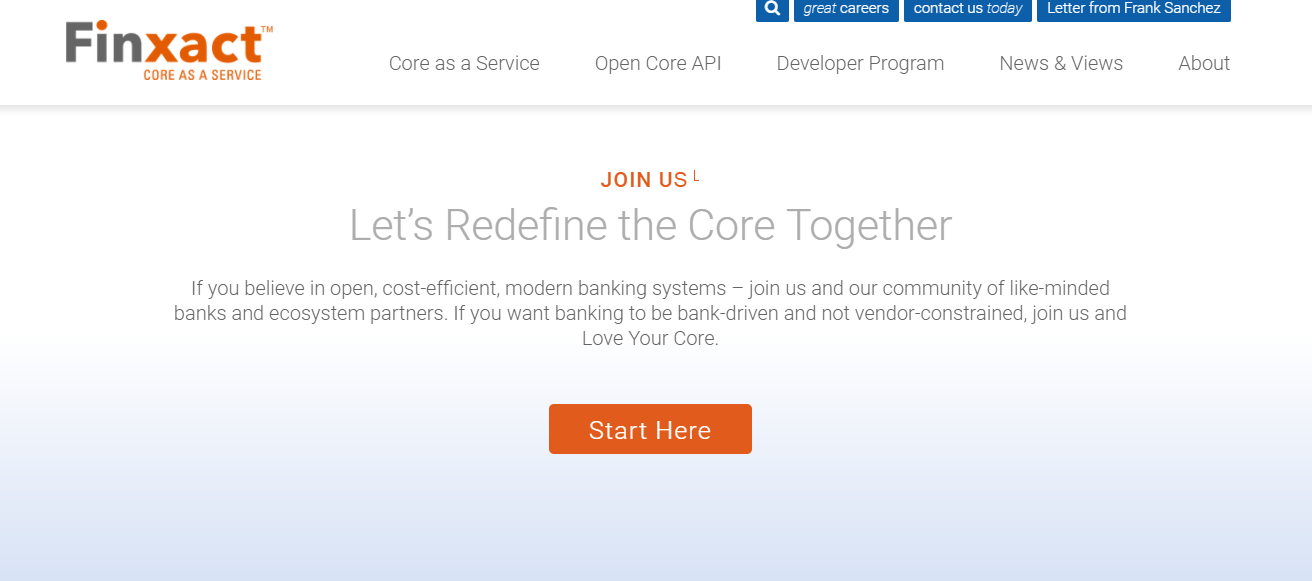Frank Sanchez of Finxact


Today we are talking to Frank Sanchez of the cloud based SaaS banking software company Finxact.
Here’s Frank with his answers to our questions – in bold.
—–
 Who are you and what’s your background?
Who are you and what’s your background?
I have spent 35+ years building and implementing core banking systems and as a FinTech company executive. My career began with a start-up called Sanchez Computer Associates where we created the first real time core banking systems for large FI’s and international markets. We were a major participant in the Internet banking explosion and our systems powered many of the first Internet banks. We took that company public with my role as CEO and experience rapid and sustained growth. In 2003 we sold the company to FIS, then one of the largest Fintech companies in the world. I served there as an executive for 8 years both as the President of Enterprise Banking, responsible for the top tier US bank market as well as Director of R&D across multiple divisions and product lines.
After retiring from FIS, I co-founded an international mobile only bank called Zenbanx. It was then, as a customer of technology, that I became acutely aware of the limitations of available technology and solutions. Like many banks, we found it very difficult to address customer needs, rapidly launch new products into the market, and respond quickly to regulators and competition. In some cases, we wanted to do some things that were simply impossible with our core banking system which was considered one of the most modern systems on the market!
I left Zenbanx shortly before it was acquired by SOFI, and I founded Finxact in late 2016 along with my brother Michael, also an experienced fintech veteran. We believed that there was a fantastic opportunity in the market for a dedicated, experience and forward-thinking team to build a new core banking system. The first thing you see when you come to our website is “Love Your Core”. It is kind of our mission, our promise to the industry, and our DNA. We believe that banks should love the heart of the bank, they should love the thing that underpins everything they do and the thing that enables them to be better innovators, more competitive, and more efficient. Core banking systems have constrained our industry for too long and we know from talking to customers and partners that there is a ton of bottled up innovation. Banks that think modernizing their core is too risky are not considering the risk of Fintech competition, or threat of financial or security breaches on old, ill-suited technology and infrastructure platforms.
What is your job title and what are your general responsibilities?
I am the CEO and founder. I both set the vision and day to day am very involved in helping my team deliver to our initial customers as we come to market. Based on my long-time experience building, implementing, operating and using core banking systems, I began creating our data and process models, schemas, technical and functional requirements, and overall architecture from scratch when we founded the company in late 2016. I curate and align the vision of an entrepreneurial team that has deep domain experience in the space. Finally, I am unofficially our Chief Focus officer. We have committed to an aggressive but achievable target deliverable and it’s my job to make sure everybody on the team is empowered to succeed and that we’re always moving toward the target.
Can you give us an overview of your business?
One of the things that makes Finxact unique is that we are focused on what we call the “core transaction engine” or the “virtual core”. This means that our core banking systems is entirely API driven through external interfaces. While we have lots of functionality and business rules ‘under the hood’, our core connects to a bank’s systems and/or their partner’s systems for things like branch banking, ATM switches, payments, statement generation, check processing, etc. We found in talking to customers that banks want a flexible, transparent, and highly agile ‘realtime posting and settlement engine’’ which they can build on top of by assembling whatever set of services they want and need – when they need them. We were the first and currently only core banking vendor to become a member of the Open API Initiative which is part of the Linux Foundation. Working with them and our partners, we have created what we think is the most open and transparent API – we call the OpenCore API. This is important because we envision a time when banks can ‘plug and play’ as they add and/or change their set of services, products and channels. So, our business model is very open, which allows us to create the best solution for our customers, that allows them to change and grow without unnecessary and lengthy integrations and customizations. This significantly cuts down the operational costs for our customers and gives them the ability to scale and innovate.
Tell us how you are funded.
We raised $12M of seed financing from a set of strategic investors including several luminary angel investors. We have not publicly announced our investors yet – in large part because some have their own strategic initiatives that they plan to launch with us. There is significant pent up innovation that we are unleashing and at least some of our strategic investors understand the competitive advantages they will have with Finxact.
Why did you start the company? To solve what problems?
I recognized the need and opportunity do something when I was a core banking customer as head of Operations and Technology of Zenbanx. As a customer, I realized first-hand the challenges a bank faces with even what I thought was the most modern core on the market. Also, that the solutions in the market were built for a different business and delivery model. At the same time, I was being approached by others in the industry with similar problems, complaining about the lack of modern options and solutions. I realized that with the modern infrastructure and technology options available, we could truly create something unlike anything else on the market. Ultimately, I started Finxact because with 35+ years of experience doing this, I see the opportunity to truly change how banks interact with their core systems, from a technical AND a business perspective. Plus, with a very small group of vendors controlling the bulk of several billion dollars being spent by banks, the business opportunity for a true challenger to bring something superior to the market is incredible.

Who are your target customers? What’s your revenue model?
Our target customers are banks that are approximately $5B to $50B in asset size. But, there are many exceptions to this as we see small banks who look like a larger bank, and we are in discussions with numerous $50B+ banks. Many banks are talking to us about “parallel banks”. We distinguish these from challenger banks who look to compete with traditional banks. Parallel banks are launched by a traditional bank as part of a new product offering and/or a new market opportunity. In some cases banks are launching parallel banks under their own brand and in other cases they are creating entirely new brands. Our first customer for example, is launching a novel, new savings product running on our core. Banks of all sizes see the advantages of having a highly scalable, native cloud based core banking system they can quickly launch a new initiative without disrupting their existing legacy systems. Of course, most also plan to migrate their legacy systems to Finxact either in pieces, or in a big bang at some point.
The strongest interest we are seeing are from banks who have the technical resources and the desire to manage an integration layer and process. Some core vendors provide a full banking suite that includes many ancillary services. Our target banks want to differentiate, they want the flexibility to construct unique offerings, and/or they find operational advantages by swapping in our out of certain vendors for various ancillary services. Our target customer just needs a core system that truly allows them to do just that. Many banks below $5B need the full suite of services. Over time, we will come to market with a complete ecosystem of partners, providing fully integrated set of ancillary services, and in some cases, bundled into our Finxact offering. For those customers who want a single solution, we’ll provide a best of breed suite of services around our core offering.
If you had a magic wand, what one thing would you change in the banking and/or FinTech sector?
The fear of conversion is irrational, data is data and it is frankly easy to move records from one system to another and to reconcile the results. It happens all the time. The biggest issue related to conversions should be the operational impact, but that should be evaluated as an opportunity to re-engineer processes, to continue to move further to a straight-through-process environment
I understand that banking is a highly regulated industry and with a lot of brand equity of high intrinsic value. Nevertheless, bankers need to create a culture that promotes innovation and some level of entrepreneurial and not consider themselves ‘custodian of the brand’.
What is your message for the larger players in the Finance industry?
We understand many of the challenges you face, the risk of a new core, the risk of a new vendor, the risk of a new company. We are experienced, realistic, and most of all, will not engage if we can’t succeed. In the end, there are risks and benefits to balance and weigh on all side, the risk and cost of the ‘status quo’ is existential.
What phone are you carrying and why?
Apple 7, seamless ecosystem / marketplace, . high quality design. Great UI. Just plain works.
Where do you get your industry news from?
Tom Brown banking weekly. American Banker.
Can you suggest the name of an Angel Investor or VC that might be interested in being profiled?
Live Oak Ventures. First Data, Woodforest Bank
What’s the best FinTech product or service you’ve seen recently?
nCino has created a fantastic application to manage the small business end-to-end origination process. Savana inc has built a mortgage workflow application that revolutionaries the process and interacts seamlessly with the FInxact core through the transactional API’s.
Finally, let’s talk predictions. What trends do you think are going to define the next few years in the FinTech sector?
I believe there will be an acceleration of innovative offerings by banks. Artificial Intelligence based needs analysis and risk modelling will allow FI’s to identify opportunities, customize products and fine tune pricing based on exacting customer profiles .
Payment systems will continue to move toward realtime good funds models, with mobile wallets and mobile banking applications initiating or authorizing the payment instructions. Major improvements in biometrics and multi-factor authentication will replace passwords and legacy authentication strategies to effectively manage identities, one of the major fraud dimensions.
Banking itself will become more realtime including realtime clearing and settlement. There is no magic in date based epochs, other than the limitations imposed by batch and legacy payment and posting systems. In the world of digital banking, money should be able to move anywhere, at anytime and for any term.
“Of course, you’ll have to implement the Finxact core to achieve that”
—–
Our thanks to Frank for his responses to our questions today. To find out more about Finxact, look them up on Finxact.com or reachout via Twitter or LinkedIn.
If you would like to receive email updates whenever we publish, sign up to our Newsletter. You can unsubscribe at any time and we will never use your email for anything else.
If you’ve any suggestions for hot FinTech companies (startup, or established ventures) that we should be profiling, or have an opinion piece to offer, or a FinTech related event you’d like to tell us about, have a look here for more details.




